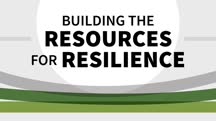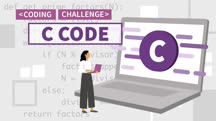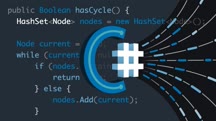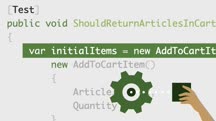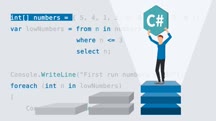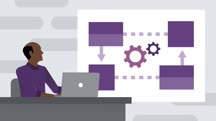Course catalog
Categories
Showing 221-240 of 1,450 items.
Building and Engaging with Your Online Following for Creators (222578)
Successful creators manage to remain true to themselves while still delivering precisely what their audience wants from them. In this course, instructor Stephanie Liu shows how to pull off this juggling act, explaining how to find and build an active online following, create stellar content, and engage with followers using top platforms. Learn how to identify your audience's needs and pump out the videos, posts, articles, and podcasts that you know they'll love. Plus, explore how to leverage Facebook and YouTube to engage with your following, including how to approach collaborations with other content creators.
Building Connection and Engagement in Virtual Teams (216067)
As a manager, whether managing your team face to face or virtually, you need to achieve goals and drive results. If your team is disengaged and disconnected, achieving business goals is challenging. In this course, Ireland-based organizational psychologist Erin Shrimpton teaches you how to apply principles of coaching and organizational psychology to foster connection and engagement and help your team thrive and deliver in a virtual work environment. Erin starts by going over the key building blocks for leading a virtual team, then covers the best ways to engage with your team both as individuals and the team as a whole.
Building Powerful Instagram Assets with Photoshop (222017)
The goal of every designer, marketer, and strategist is to protect and maintain the distinctive elements of a brand while building engaging visuals. In this course, find out how Photoshop provides the flexibility to develop striking social media assets to represent powerful and recognizable business identities. Visual strategist Kladi Vergine covers real-world seamless Photoshop and Illustrator workflows for developing branded professional Instagram assets. Join Kladi as she shows you how to leverage professional vector assets from Adobe Stock, take advantage of Creative Cloud Libraries to speed up your workflow between apps, use Capture to create a color theme from any image, generate social media templates to promote your brand, and use the video timeline to increase your online engagement with animated content.
Building RESTful APIs in Laravel (220691)
APIs serve as a bridge between different applications or systems, allowing us to efficiently share our data with the world. REST, an architectural style that defines how to build APIs, is popular, modern, and lightweight. In this course, discover how to create a RESTful API of your own. Join instructor Zuzana Kunckova as she demonstrates how to build a RESTful API using Laravel, the popular PHP framework. Learn how to set up your application, including how to create the database structure and set up RESTful API routes. Discover how to build your RESTful API and save, display, update, and delete resources Plus, explore how to use Postman to test your API and ensure that it works as expected.
Building the Classic Snake Game with Python (218311)
Are you looking for a fun, meaningful way to level up your Python programming skills? In this course, instructor Robin Andrews shows you how to put together what you need to know to build the Python version of a classic Snake game. Robin introduces you to turtle graphics and how you can use and control animation using Python turtle graphics. He explains global variables and shows you how to draw with turtle graphics by using stamps. With these pieces in place, it’s time to work on the game itself! Robin walks you through how to represent the snake, move it around the screen, and control the snake’s direction. He discusses the game loop that is used to control the game and also goes over how to add snake food to the game, implement a scoring system, and reset the game. Robin finishes up with advice on how to use Lambda expressions to avoid repetition in your game and some fun ways to personalize your game.
Building the Resources for Resilience (231401)
What does resilience really mean? Many people define resilience as personal grit, but studies show that resilience is more about the resources you have that bring out the grit. In this audio-only course, Dr. Michael Ungar shares insights from his decades-long research into resilience to reveal that it’s not about your ruggedness, but rather your resources. Michael explores parts of your external environment that you can curate to boost your resilience. He details 12 resources that can help you build resistance into your life and then goes into small, safe moves you can make in order to create more resources that you can rely on. What do you do when you run out of resources? Michael discusses ways that adjusting your mindset and your expectations can help. He concludes by describing how new behaviors come from new environments.
This course was created by Pete Mockaitis of How to Be Awesome at Your Job. We are pleased to offer this training in our library.

This course was created by Pete Mockaitis of How to Be Awesome at Your Job. We are pleased to offer this training in our library.

Building Your Marketing Technology Stack (210168)
While digital marketing has matured, it has also become more complex, and marketers need to think of its many components holistically. A marketing technology, or martech, stack is the set of tools that your marketing team uses to plan, execute, and measure all aspects of your digital marketing objectives. With the explosion of new capabilities, vendors, platforms, and technologies in this space, it's more important than ever to carefully choose your components and build the stack that's right for your organization. In this course, David Booth walks you through a framework that examines the roles and benefits of each layer in the stack—acquisition through marketing and advertising, digital experiences and clickstream measurement, the back-office functions, and analysis. Learn how these technologies can help you drive engagement, measure results, increase sales, and improve customer relationships.
Note: While specific software and platforms aren't endorsed, you can see how tools such as a customer relationship management system, web analytics, and more work in a successful marketing mix.
Note: While specific software and platforms aren't endorsed, you can see how tools such as a customer relationship management system, web analytics, and more work in a successful marketing mix.
Building Your Visibility Online as a Remote Leader (234546)
Much of your day-to-day work likely requires you to interact with only a select few teams or colleagues. But as a leader, visibility is key to advancing your agenda. Your teams need to see you show up to lead and provide reassurance. And, as more organizations embrace a mixture of remote and onsite work, consistent communication from leadership is even more critical. In this course, learn how to intentionally manage and boost your visibility when working with remote teams. Communications and media expert Jessica Chen explains how to sketch out a remote visibility strategy that works, maintain a consistent messaging schedule, and build valuable relationships with senior leaders from afar. Jessica also goes over the different platforms and strategies you can use to boost your visibility, including how to stream virtual town halls and stay connected using recorded video messages.
Business Analysis for Project Managers (209981)
Business analysis may seem like a broad term, but it fulfills a very specific demand within a company’s operations. A business analyst identifies business needs, and recommends relevant solutions and the requirements needed to deliver those solutions. However, some companies may not have dedicated business analysts, and it often falls to project managers to perform business analysis duties. In this course, Greta Blash shows project managers how to incorporate business analysis into their workflow.
Greta illustrates the concepts by looking at a topic familiar to project managers—projects—through the lens of business analysis, starting with the pre-project phase where needs are identified, to identifying stakeholders, developing a project roadmap, analyzing requirements, all the way to closure and deployment. By the end of this course, you’ll be able to employ business analysis concepts to avoid inefficiencies, mistakes, and reworking, and deliver your projects on budget and on time.
Greta illustrates the concepts by looking at a topic familiar to project managers—projects—through the lens of business analysis, starting with the pre-project phase where needs are identified, to identifying stakeholders, developing a project roadmap, analyzing requirements, all the way to closure and deployment. By the end of this course, you’ll be able to employ business analysis concepts to avoid inefficiencies, mistakes, and reworking, and deliver your projects on budget and on time.
Business Analysis: Essential Facilitation and Workshop Skills (214673)
To effectively analyze business needs and deliver quality solutions that address these business needs, key facilitation skills are needed in various workshop settings—in virtual and in-person, as well in agile settings—to identify, verify and validate this important information. This course from business analyst Jamie Champagne covers how to facilitate sessions from one-on-one meetings to large workshops with common examples of activities business analysts or anyone doing business analysis work often perform. Jamie demonstrates the differences in approach to in-person activities versus virtual facilitation and how to deliver value in each. Additionally, she details these skills on both traditional, plan-based work as well as more agile and adaptive techniques. Finally, Jamie explains how you can continue to facilitate teams and participate in workshops even when you are not the one running the session.
Business Benefits Realization Foundations (232217)
Increased competition, globalization, and shifting technologies are just some of the contributing factors that require today's organizations to up their game to ensure the money they invest in product development is spent on the highest-valued efforts. Without a clear approach to define how programs and projects are selected, funded, and managed, organizations may end up delivering solutions that have a high probability of failure. Such failures include missing customer expectations, solving the wrong problems, or misaligning solutions with the direction the enterprise is moving.
In this course, Laura Paton provides an introduction to business benefits realization, a practice designed to help organizations select the best change initiatives and ensure the proposed changes deliver and sustain business value. Laura breaks down the components of business benefits realization—introducing a five-part life cycle—and explains the steps for producing key business benefits deliverables.
In this course, Laura Paton provides an introduction to business benefits realization, a practice designed to help organizations select the best change initiatives and ensure the proposed changes deliver and sustain business value. Laura breaks down the components of business benefits realization—introducing a five-part life cycle—and explains the steps for producing key business benefits deliverables.
Business Innovation Foundations (214367)
Innovation is an exciting opportunity to get more engaged in your work, to solve problems, and be creative. Learn more about innovation practices and the skills and mindsets required for innovation, in this course with expert Keith Hopper. Discover why innovation is so important to your company’s growth and your career. Then explore the unique skills common to the world’s best innovators and learn to cultivate them in your current role. Next, identify opportunities to innovate by talking to your users and customers, and learn how to use testing to validate those ideas and generate more solutions. Finally, learn how to build a culture of innovation by applying agile principles to initiatives and engaging coworkers and managers in collaborative and open-ended conversations. By the end of this course, you should walk away energized and excited about the possibilities for innovation at your organization.
Business Innovation Foundations (2014) (225706)
Innovation propels companies forward. It's an unlimited source of new growth and can give businesses a distinct competitive advantage. Learn how to innovate at your own business using Systematic Inventive Thinking, a method based on five techniques that allow you to innovate on demand. In this course, author and business school professor Drew Boyd shares the techniques he's taught Fortune 500 companies to innovate new services and products. Drew provides real-world examples of innovation in practice and suggests places to find your own opportunities to innovate.
In the bonus chapter, Drew shares insights from his own career and answers tough questions on resistance to innovation, innovation and leadership, and the difference between generating vs. executing innovative ideas.
In the bonus chapter, Drew shares insights from his own career and answers tough questions on resistance to innovation, innovation and leadership, and the difference between generating vs. executing innovative ideas.
C Code Challenges (218362)
All programmers must keep their coding muscles toned, which requires regular challenges and review of best practices. Beginners desire realistic exercises to continue their education, and experienced coders must constantly brush up on the basics as well as those areas of C that programmers often have issues with, such as pointers, recursion, and systems programming. In this course, Dan Gookin provides challenges for coders across the C knowledge spectrum with regular exercises to keep their programming skills fresh and ready for their next opportunity.
C# Algorithms (218430)
Algorithms are one of the fundamental pillars in every software application, and once you understand them, you can create more efficient and maintainable programs. In this course, instructor Kathryn Hodge shows you how to create better C# programs by using efficient algorithms. Kathryn discusses what makes an algorithm effective, as well as how to make informed assumptions about your data to create better algorithms. She focuses on how to create efficient algorithms to work with different types of data, including strings, arrays, linked lists, queues, stacks, hash-based structures, and trees. Many algorithms are built into the C# language, and Kathryn covers how to use these to create your own custom algorithms, so you can work with your data exactly the way you want. She also dives into how to leverage different data structures to create better algorithms in analyzing or manipulating their data.
C# Best Practices for Developers (140128)
Get into the habit of developing reliable, readable, and sustainable application code by following coding standards with C#. In this course, join instructor Reynald Adolphe as he shows how to go beyond the language syntax and master best practices that can help you produce high-quality C# code. Throughout the course, Reynald shares some of his favorite best practices, illustrating precisely when and where to use each one. Learn about right way to use constructors, manage objects, implement often ignored advantages of getters and setters. Plus, explore best practice resources, including those for essential design patterns.
C# Design Patterns (209488)
Design patterns are an important part of programming. Rather than programming solutions to every issue from scratch, developers can implement these patterns that solve common problems. In this course, instructor Richard Goforth explains the purpose and effective use of key design patterns in C#. Richard begins by discussing why design patterns make sense, what they are, and how they are grouped and categorized. He then provides an overview of the creational, behavioral, and structural Gang of Four design patterns and how they are applied in C# and .NET. Next, he takes a deeper dive into the Iterator, Factory Method, and Adapter patterns, providing hands-on challenges that help you master the application of these patterns in your own code.
C# Test-Driven Development (218515)
The old carpentry adage “measure twice, cut once” may not seem applicable to programming, but when you consider all the ill effects that bad code can have down the line, doesn’t “test twice, code once” make sense? The later you test, the more effort it requires to fix any issues that may have been introduced months ago. With test-driven development, you create the test first, and then you write the code. In this course, Christian Wenz shows how to apply TDD principles to C# programming. Christian takes a look at TDD in theory (what does it mean and what does a programmer need to know?), as well as in practical terms (how do you use TDD for C#-based projects?). He also illustrates TDD in action by adding tests, offers advice to help programmers understand available frameworks, and looks at more complex scenarios for using TDD like testing web applications and APIs, and replacing database objects during a test.
C#: Advanced Practices (221184)
In this course, instructor Mika Dumont introduces you to C# advanced practices. Mika begins by defining LINQ and showing you how LINQ makes it easy to query any data source. She walks you through how LINQ composes queries written in multiple statements, or even multiple methods, into a single query operation. Mika covers how LINQ works with Entity Framework to query SQL data sources. She describes how async features make it easy to write code that describes what your code does. She goes into how the Task class helps you organize asynchronous algorithms in logical ways. She steps you through how to recover and process asynchronous error conditions from faulted tasks. Mika concludes by explaining the similarities and differences between asynchronous operations and multithreaded, how you can apply similar techniques in both contexts, and how asynchronous operations may be single-threaded.
This course was created by Microsoft.NET. We are pleased to host this training in our library.
This course was created by Microsoft.NET. We are pleased to host this training in our library.
C#: Design Patterns Part 1 (221507)
Design patterns are an important part of programming. Rather than programming solutions to every issue from scratch, developers can implement these patterns that solve common problems. In this course, instructor Richard Goforth explains the purpose and effective use of key design patterns in C#. Richard begins by discussing why design patterns make sense, what they are, and how they are grouped and categorized. He then provides an overview of the creational, behavioral, and structural Gang of Four design patterns and how they are applied in C# and .NET. Next, he takes a deeper dive into the Iterator, Factory Method, and Adapter patterns, providing hands-on challenges that help you master the application of these patterns in your own code.





